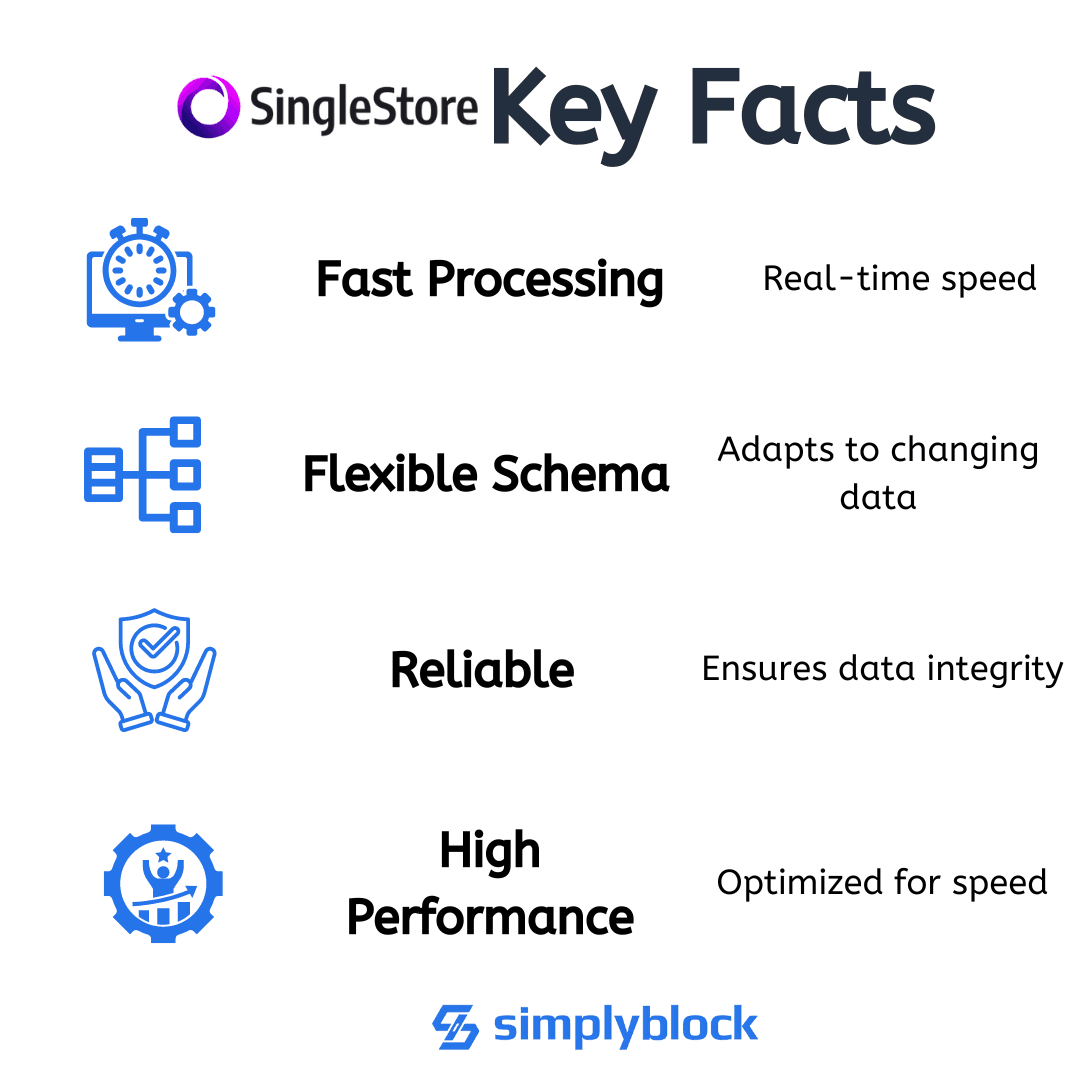SingleStore
Terms related to simplyblock
SingleStore is a high-performance, distributed SQL database that combines transactional (OLTP) and analytical (OLAP) workloads into a unified engine. Formerly known as MemSQL, SingleStore is designed for speed, scalability, and real-time analytics. It supports ANSI SQL, runs in-memory or on disk, and scales horizontally across commodity hardware or cloud infrastructure. By converging operational and analytical processing, SingleStore enables enterprises to build data-intensive applications with low latency at scale.
How SingleStore Works
SingleStore uses a distributed architecture with two key components: aggregators and leaf nodes. Aggregators manage query coordination, while leaf nodes store and process data. Each node uses vectorized execution, compiled queries, and just-in-time code generation to achieve sub-millisecond response times.
It supports rowstore for fast transactional queries and columnstore for analytical workloads. Data can reside in-memory or on NVMe storage, depending on workload characteristics and cost-efficiency requirements. The engine automatically routes queries to appropriate storage types, optimizing performance.
SingleStore and NVMe Storage
NVMe storage enhances SingleStore’s performance, particularly for columnstore tables with high scan and aggregation operations. SingleStore performs parallel reads and writes across nodes, so pairing it with distributed NVMe storage enables consistent throughput and latency as data scales.
Simplyblock’s software-defined storage enables SingleStore to achieve near in-memory speed over standard Ethernet via NVMe over TCP. The result is reduced hardware cost, improved resource utilization, and faster time-to-query for real-time applications.

SingleStore vs Traditional Databases : Key Differences
| Feature | SingleStore | Traditional RDBMS (e.g., MySQL, PostgreSQL) |
|---|---|---|
| Architecture | Distributed, in-memory or NVMe-backed | Monolithic, disk-based |
| Query Processing | Vectorized execution, compiled SQL | Row-by-row processing |
| Workload Type | Mixed OLTP and OLAP | OLTP or OLAP (not both efficiently) |
| Horizontal Scaling | Native, elastic | Limited, often requires sharding |
| Storage Optimization | NVMe-accelerated hybrid storage | HDD/SSD focused |
Storage Requirements for SingleStore
SingleStore thrives on low-latency, high-throughput storage. Whether deployed on-premises, in the cloud, or at the edge, optimal performance depends on:
- High IOPS: For transactional consistency across nodes
- Fast sequential reads: For columnstore scan operations
- Snapshot support: For backup, disaster recovery, and migrations
- Low tail latency: To prevent outliers in large parallel queries
- Scalability: As data volume grows in real-time apps
Simplyblock™ offers erasure-coded storage with advanced volume-level snapshots and Kubernetes-native provisioning, streamlining SingleStore operations.
SingleStore on Kubernetes
SingleStore supports cloud-native deployment using Helm charts and operators, enabling fast provisioning in Kubernetes environments. However, the underlying persistent storage must meet the database’s stringent performance profile.
With simplyblock’s CSI integration, SingleStore volumes can be provisioned dynamically, backed by NVMe-over-TCP block storage. Key benefits include:
- Instant provisioning with high-availability volumes
- Support for dynamic scaling and replica creation
- Multi-zone deployment for fault-tolerance
- Compatibility with hybrid-cloud Kubernetes platforms such as Amazon EKS or OpenShift
Use Cases of SingleStore
SingleStore supports a wide range of latency-sensitive and analytical workloads. Common use cases include:
- Real-time dashboards and operational analytics
- Machine learning feature stores
- Fraud detection and risk analytics
- Time-series and telemetry processing
- Customer personalization engines
Enterprises leveraging hybrid or multi-cloud storage benefit from consistent performance across clouds and edge data centers.
Relevant Simplyblock™ Features for SingleStore
Key features of simplyblock for SingleStore environments:
- NVMe-over-TCP protocol for high-performance networked storage
- Advanced erasure coding for durability without 3x replication
- Copy-on-write snapshots for backups and testing
- Kubernetes-native volume lifecycle management
- Multi-tenant QoS with logical isolation
External Resources
- SingleStore Official Website
- SingleStore Documentation
- ANSI SQL Overview – Wikipedia
- Distributed SQL – Wikipedia
- Benchmarking OLAP Databases
Questions and Answers
SingleStore (formerly MemSQL) is built for real-time data applications that need both OLTP and OLAP capabilities. It uses a unified architecture to support high-speed transactions and analytics on the same data, making it ideal for dashboards, streaming pipelines, and modern SaaS platforms.
Yes, SingleStore supports containerized deployments and provides an official Kubernetes Operator. For performance and persistence, it pairs well with Kubernetes-native NVMe storage that ensures fast recovery, high throughput, and consistent latency.
SingleStore thrives on fast, low-latency I/O for both ingest and analytics. NVMe over TCP or software-defined storage provides the ideal balance of performance, scalability, and cost-efficiency for demanding workloads.
Yes, SingleStore offers native encryption at rest and in transit. For stronger compliance and isolation, especially in multi-tenant environments, it’s recommended to use volume-level encryption managed at the storage layer with per-tenant keys.
Absolutely. SingleStore supports horizontal scaling with distributed processing. To ensure consistent performance under high concurrency, it should be combined with NVMe-backed storage that minimizes latency during parallel reads and writes.
